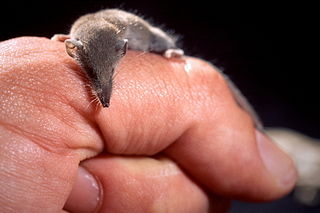
The Etruscan shrew, also known as the Etruscan pygmy shrew, white-toothed pygmy shrew and Savi’s pygmy shrew, is the smallest known extant mammal by mass, weighing only about 1.8 g (0.063 oz) on average.

The red-toothed shrews of the subfamily Soricinae are one of three living subfamilies of shrews, along with Crocidurinae and Myosoricinae. In addition, the family contains the extinct subfamilies Limnoecinae, Crocidosoricinae, Allosoricinae and Heterosoricinae. These species are typically found in North America, northern South America, Europe and northern Asia. The enamel of the tips of their teeth is reddish due to iron pigment. The iron deposits serve to harden the enamel and are concentrated in those parts of the teeth most subject to wear. Members of the genera Chimarrogale, Nectogale, Neomys (Nectogalini) and some members of Sorex (Soricini) are known as water shrews, due to having a semi-aquatic lifestyle.

The Arctic shrew, also known as the blackback shrew or saddlebacked shrew, is a medium-sized shrew found in Canada and the northern United States. Separate species status has been proposed for the maritime shrew which is found in New Brunswick and Nova Scotia and had been considered to be a subspecies of the Arctic shrew. The tundra shrew was formerly considered to be a subspecies of the Arctic shrew.
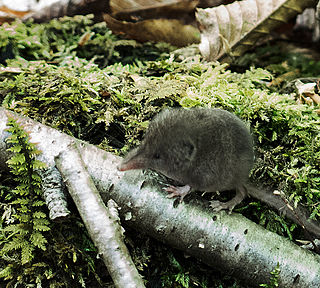
The North American least shrew is one of the smallest mammals, growing to be only up to 3 inches long. It has a long pointed snout and a tail never more than twice the length of its hind foot. The dense fur coat is either grayish-brown or reddish-brown with a white belly. Its fur becomes lighter in the summer and darker in the winter. Although similar in appearance to several species of rodents, all shrews are members of the order Eulipotyphla and should not be mistaken for a member of the order Rodentia. The North American least shrew's eyes are small and its ears are completely concealed within its short fur, giving it very poor eyesight and hearing.

The vagrant shrew, also known as the wandering shrew, is a medium-sized North American shrew. At one time, the montane shrew and the Orizaba long-tailed shrew were considered to belong to the same species.

The genus Cryptotis is a group of relatively small shrews with short ears, which are usually not visible, and short tails, commonly called small-eared shrews. They have 30 teeth and are members of the red-toothed shrew subfamily. Since 1992, Neal Woodman at the United States National Museum has been in the process of revising the genus. To date, this has resulted in an increase in the number of species from 12 to 30.

The long-tailed vole, in some areas known as the San Bernardino long-tailed vole, is a small vole found in western North America. They have short ears and a long tail. Their fur is gray brown with light gray underparts. They are around 18 cm (7.1 in) long with an 8 cm (3.1 in) tail and weigh about 50 g (1.8 oz).

The dusky caenolestid, also known as Tate's shrew opossum, is a shrew opossum from South America. The dusky caenolestid is characterized by a dark brown coat with a lighter underbelly, soft and thick fur, and a loosely haired tail. A nocturnal animal, the dusky caenolestid lives on trees and feeds on insects and small invertebrates and vertebrates. It occurs in alpine and páramo forests in northern and western Colombia, Ecuador, and western Venezuela. The IUCN classifies this shrew opossum as least concern.

The broad-eared bat or broad-tailed bat is a species of free-tailed bat from the Americas.
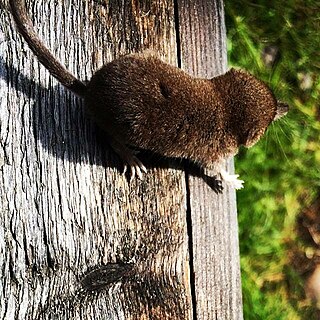
Laxmann's shrew, or the masked shrew, is a species of shrew. Its range extends from northern Scandinavia and the Baltic to the Sea of Japan, including Hokkaidō, Sakhalin, and the Korean Peninsula. It favours mountain forests but is sometimes found in tundra and moorland, and also in lowland areas as well. It avoids cultivated land.

The black-eared mouse, or black-eared deer mouse, is a species of rodent in the family Cricetidae, native to North America.

The large-eared tenrec is a species of mammal in the family Tenrecidae. It is the only species in the monotypic genus Geogale, and the only member of the subfamily Geogalinae. It is endemic to Madagascar where its natural habitats are subtropical or tropical dry forests and shrubland. It is threatened by habitat loss, but to a lesser extent than was previously thought and is listed by the IUCN as being of "Least Concern".
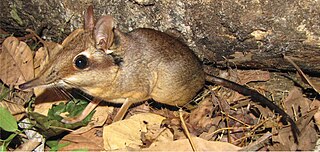
The four-toed elephant shrew or four-toed sengi is the only living species in the genus Petrodromus, which together with five other extant genera Rhynchocyon, Macroscelides, Petrosaltator, Galegeeska and Elephantulus constitutes the order Macroscelidea. This species is only found in particular regions in Africa and is smaller than its relatives. A comprehensive record of this species is lacking.

The African giant shrew is a species of white-toothed shrew. It also is known as, Mann's musk shrew, Euchareena's musk shrew, or Olivier's shrew. It is native to Africa, where it has a widespread distribution and occurs in many types of habitat. Its natural habitats are subtropical or tropical dry forest, subtropical or tropical moist lowland forest, subtropical or tropical moist montane forest, dry savanna, moist savanna, arable land, rural gardens, urban areas, and heavily degraded former forest. In the Nile Valley it is found near human habitation, where it is considered to be a pest. It is a common species and is listed by the International Union for Conservation of Nature as being of "least concern".

Goodwin's broad-clawed shrew is a species of mammal in the shrew family, Soricidae. Body length and size of adults average 9.49 cm (3.74 in) and 7.0 g (0.25 oz) respectively making it a relatively larger shew. What distinguishes this from other shrews are its long claws.

The forest shrew is a species of shrew in the mouse shrew family, Soricidae. It is found in Lesotho, South Africa, and Eswatini. Its natural habitats include temperate forests, dry savanna, Mediterranean-type shrubby vegetation, and temperate grassland. The term "forest shrews" in the plural is sometimes confusingly used to collectively refer to a different genus, Sylvisorex.
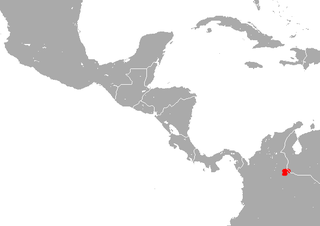
The Tamá small-eared shrew is a species of mammal in the family Soricidae. It is known from the Cordillera Oriental of Colombia and the Páramo de Tamá of western Venezuela, where it has been found primarily in cloud forest at elevations between 2,380 and 3,330 m. Its range includes Venezuela's El Tamá National Park. The closest relatives of the species are C. meridensis and C. thomasi.

The Guatemalan broad-clawed shrew is a species of small-eared shrew in the family Soricidae. It is known from Guatemala and the Mexican state of Chiapas, where it has been found in montane forests of oak, pine and fir, as well as secondary forest, at elevations above 2,100 m (6,900 ft). It feeds on insects. Deforestation and habitat fragmentation are major threats, particularly in Chiapas. It was formerly considered conspecific with C. goldmani.

The long-tailed shrew or rock shrew is a small shrew found in Atlantic Canada and the Northeastern United States.

The Táchira Depression is a saddle of land connecting the Lake Maracaibo basin to the Orinoco basin in the state of Táchira, Venezuela. It forms a break in the eastern Andes, separating the Tamá Massif to the west from the Cordillera de Mérida to the east. The depression has been thought to present a barrier to the movement of species between the Colombian and Venezuelan Andes, but this effect may have been relatively low during the recent ice ages. The mountains of the region have potential for coffee farming and hydroelectric power generation, while the lower levels are suitable for farming.




















